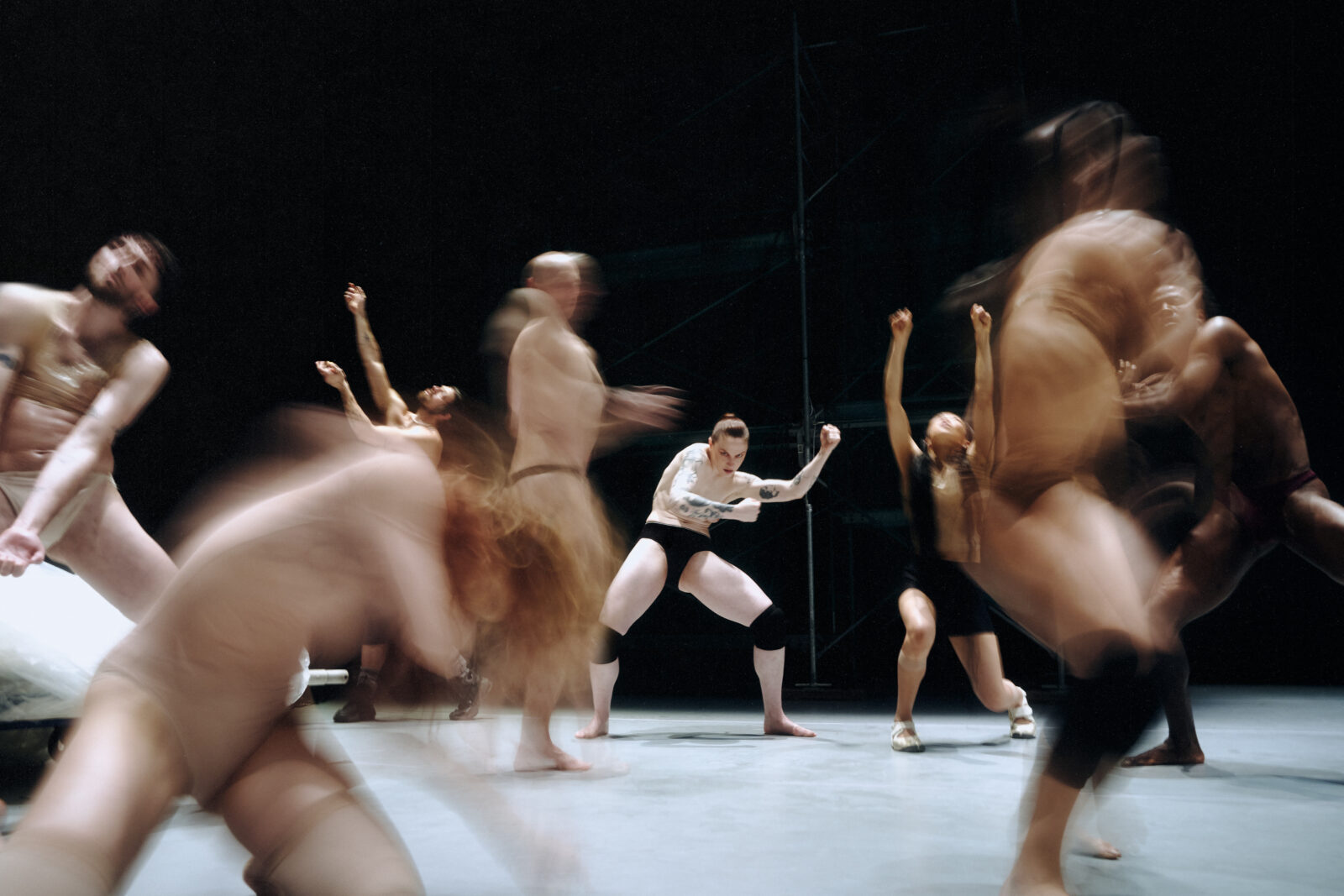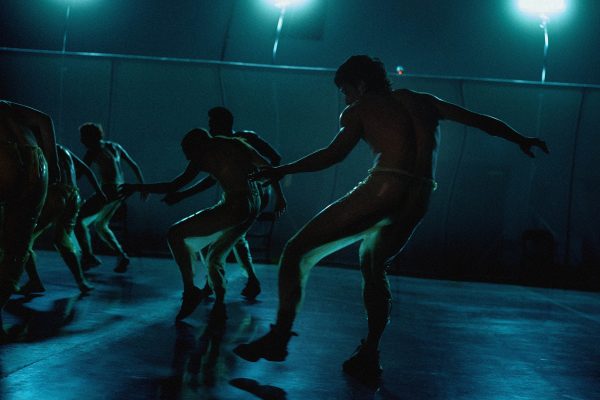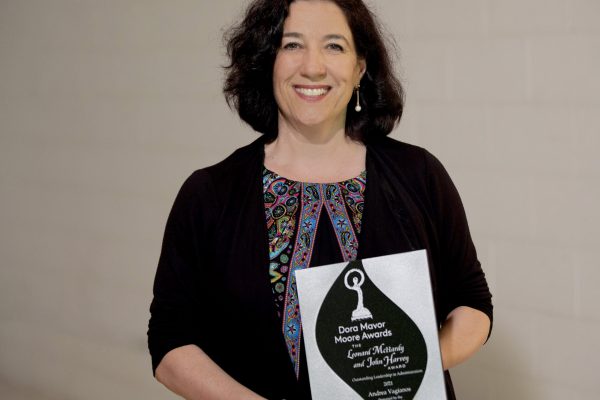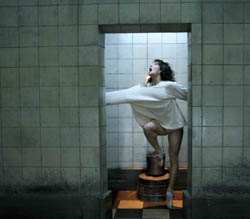On Thursday, July 13, Andrea Peña and Artists (AP&A) opened the Venice Biennale’s 17th International Festival of Contemporary Dance with the world premiere of its latest work, Bogotá.
Peña, a Colombian based in Montreal, is the first artist to win the Biennale’s call for new choreographic work by an artist under the age of 35. When selecting Peña as the winning choreographer, Wayne McGregor, director of the Biennale’s dance department, described Bogotá as “a radical and innovative proposal that convinces in its brave and raw approach to new movement exploration and evolving hybrid forms.”
The Dance Current spoke with Peña about creating under exciting but unexpected deadlines, meaningful multidisciplinarity and occupying the in between.
Dylan Schoenmakers: Congratulations on being the first artist to win the Venice Biennale’s international call for new choreographic work. What was your reaction when you received the news, and how are you preparing yourself for such a prominent world premiere?
Andrea Peña: It’s funny. We were in residency in Italy, in Naples, with two dancers from the team and one of our collaborators. It was late at night when I got an email with the news. I immediately was in shock. I started crying, I was on the floor. [Laughs] So dramatic. My ex-partner at the time, they were with me, and we shared a beautiful moment. The dancers then came into the living room, and the four of us lived this moment of [recognizing that] we’re going to come back to Italy in less than a year and bring a new work.
Bogotá is a piece we were working on for a while, gently researching. The premiere in Montreal wasn’t happening until December 2024, and then we found out about Venice in October 2022, which gave us about seven months to finish the show that I thought we had two years for.
DS: Oh my gosh.
AP: This piece is extremely ambitious. We’re really renewing our practices as a team: my practice as a choreographer, theirs as interpreters, really trying to challenge what we already knew. I wanted to give myself two years for that experience, and we’ve had seven months. So it’s been an incredible journey to see – because of all the research, and it’s a team that I’ve been working with, some for seven or eight years – how quickly the piece has come together.
DS: And how have you adapted your practice? Obviously, it’s never ideal to have such time constraints. What kinds of accommodations have you made?
AP: I don’t think we’ve accommodated. I told my team – this was two and a half years ago, when we started researching ideas – I said, I really want to figure out how to build a piece from the back door. I want to build a piece from behind, from the subconscious. I don’t want to build a piece that choreographically comes from the top down, but rather see how, through our years of collaboration and co-creation, this work can build itself organically from bottom up.
That’s something that has given this work a particular light and life. We started with training the team on practices of listening, intuition, interpretation, feeling ideas, improvisation. So when we got to a choreographic construction, starting in October, the thing built itself so fast because we had been developing tools, methods, approaches and practices for two years.
DS: How did the idea or intention for the work first emerge?
AP: It took me about a year and a half to face myself and accept that I wanted to make a piece about death, resurrection and rebirth. I felt that it was way too big a theme to take on. During the pandemic years, I started thinking about how we as human beings go through cycles of life, death and rebirth, beyond our traditional notions of life and death. And how the pandemic for a lot of people was like a mini life cycle, where parts of our past were dying and we were re-questioning ourselves. It got me thinking, what does that look like energetically in bodies? What does that look like within choreographic ideas?
I’m also an industrial designer and worked a lot in fashion, so I have a very ‘art direction’ approach to the way I work. When I work, I create a bank of, I would say, over 100 images of what I feel are nuances of what the work is asking to be. In that search for these forms, I fell on a lot of baroque imagery and baroque painting. That’s where this notion of rebirth and resurrection started linking to the baroque, and exploring the baroque as images in the bodies of the dancers. And the bodies of AP&A and the majority of my collaborators are Queer bodies, so we started exploring a Queering practice of these images.
I started sitting with these questions of death, and life cycles, and the baroque, and I realized in my own culture we have a very proximal relationship to death – to the history of the country, not only colonially speaking but also in terms of the internal war that Colombia lived through. Through that hardship, it’s a culture that has found strength, resilience, celebration and joy. That’s where this notion of Bogotá started coming forward, and realizing that there’s something about returning to my culture with these themes.
DS: On the subject of hybridity, Bogotá is an intersection of contemporary dance, visual arts and fashion. What value does multidisciplinarity hold for you and your company?
AP: As somebody who literally just finished my master’s in industrial design two months ago –
DS: Oh, wow! Congrats on that too!
AP: Thank you! [Laughs] While trying to build this piece, it’s been insane. But I really put myself in this intersection. I literally have a tattoo that says, “Be in between.” As somebody who is both Colombian and Canadian, I’m in between because when I go home, I’m very Canadian; when I’m here, I feel very Colombian. I’m fascinated with the in between of gender and sexuality and expression; and in terms of practice, maybe not the in between, but where all of these things meet. What I’m interested in is not only how these practices frame or decorate each other, but how these practices fundamentally affect each other.
In Bogotá, for example, I call it a landscape. I don’t really call it scenography because it’s not a scenography that is there to decorate; it’s a landscape that is there for the dancers to interact, and it’s a landscape that is there to propose behaviours on the bodies of the dancers in real time. It’s about how these different practices alter, effect and influence not aesthetic representation but actual lived experiences in the body.
DS: Your website describes this new creation as one that “anchors, explores and challenges the practices that have carved AP&A’s unique hybrid language.” How do you situate Bogotá in relation to your other works?
AP: Honestly, it’s a massive step up. Yesterday, we had a conversation with the team after the run and we just had to acknowledge that this is an extremely hard work. It’s hard work for me as a choreographer and thinker; it’s super fucking hard for them as interpreters. I never want to use methods, mechanics or structures that worked from previous works in new ones, in order to easily find things that could succeed choreographically. So every time I choreograph, I feel like I have no idea what I’m doing.
The notion of landscape in this work is much more integrated. The dancers literally sometimes are doing loops of repetition inside scaffolds. They are negotiating inside objects that propose choreographic starting points in their bodies, and they are very much in dialogue with these objects, constantly. Without the objects, we can’t really rehearse. For this whole period, we’ve had to find so many technical residencies in theatres because we can’t activate the work necessarily in studio because the conversation of body and materiality in this work is extremely anchored, the dialogue between [industrial] design and choreography.
DS: The work will eventually tour Colombia, including a presentation in Bogotá. What will it mean for you to bring this piece there?
AP: Personally, just to make this work is huge. With my team, I’ve cried so many times. The national anthem of Colombia shows up 50 minutes into the work, and to hear this anthem from my country. The Colombian anthem is very patriotic in a way. It’s an anthem that is there because we gained Colombia back from the Spanish. It’s an anthem that really has a lot of weight in terms of the love that we have for our people and our country, and also acknowledging the history. To hear that in a theatre on massive speakers, I fall apart every time.
It’s been really beautiful to engage with my team on a personal level, where they get to know who I am more deeply and understand where I come from. I had one of my dancers a few years ago ask me, ‘Andrea, why is your work so hard? Why are you searching for a lot of resilience in the body?’ And I said, “Well that’s because that’s where I come from. I come from resilience, I come from struggle, I come from a community, a people, a nation that had to fight. I’m an immigrant, I’m a child of immigrants, all that is sewn in.”
This conversation has been edited for clarity.
Dance Media Group strengthens the dance sector through dialogue. Can you help us sustain national, accessible dance coverage? Your contribution supports writers, illustrators, photographers and dancers as they tell their own stories. Dance Media Group is a charitable non-profit organization publishing The Dance Current in print and online.

Tagged:





